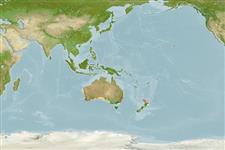Actinopterygii (ray-finned fishes) >
Gobiesociformes (Clingfishes) >
Gobiesocidae (Clingfishes and singleslits) > Gobiesocinae
Etymology: Cochleoceps: Greek, kochlea = snail like + Latin, ceps, caput = head (Ref. 45335).
Environment / Climate / Range
Ecology
Marine; demersal; depth range 3 - 40 m (Ref. 9002). Subtropical, preferred ?
Southwest Pacific: New South Wales and eastern Victoria, Australia.
Size / Weight / Age
Maturity: Lm ? range ? - ? cm
Max length : 5.5 cm TL male/unsexed; (Ref. 9002)
Short description
Morphology | Morphometrics
Dorsal
spines
(total): 0;
Dorsal
soft rays
(total): 5-6;
Anal
spines: 0;
Anal
soft rays: 4 - 6. Caudal fin rounded (Ref. 9002). Pelvic fins united into moderate-sized double sucking-disc, posterior half with a fleshy fringe (Ref. 9002). Greenish-yellow to orange with small scattered dark spots to larger red spots, variable in density; iridescent blue dashes or lines dorsally and across sides over head and body (Ref. 9002).
Adults usually on kelp, on which they deposit their eggs, which are guarded by the male, although the female is often present as well (Ref. 9002). Often on ascidians or sponges in deep water, probably depositing eggs on algae nearby (Ref. 9002). Often observed cleaning boxfishes, porcupine fishes and morwongs (Ref. 9002).
Life cycle and mating behavior
Maturity | Reproduction | Spawning | Eggs | Fecundity | Larvae
Kuiter, R.H., 1993. Coastal fishes of south-eastern Australia. University of Hawaii Press. Honolulu, Hawaii. 437 p. (Ref. 9002)
IUCN Red List Status (Ref. 115185)
CITES (Ref. 94142)
Not Evaluated
Threat to humans
Harmless
Human uses
More information
Common namesSynonymsMetabolismPredatorsEcotoxicologyReproductionMaturitySpawningFecundityEggsEgg development
Age/SizeGrowthLength-weightLength-lengthLength-frequenciesMorphometricsMorphologyLarvaeLarval dynamicsRecruitmentAbundance
ReferencesAquacultureAquaculture profileStrainsGeneticsAllele frequenciesHeritabilityDiseasesProcessingMass conversion
Tools
Special reports
Download XML
Internet sources
Estimates of some properties based on models
Phylogenetic diversity index (Ref.
82805): PD
50 = 0.5312 [Uniqueness, from 0.5 = low to 2.0 = high].
Bayesian length-weight: a=0.00550 (0.00238 - 0.01266), b=3.11 (2.91 - 3.31), in cm Total Length, based on LWR estimates for this (Sub)family-body shape (Ref.
93245).
Trophic Level (Ref.
69278): 3.2 ±0.3 se; Based on size and trophs of closest relatives
Resilience (Ref.
69278): High, minimum population doubling time less than 15 months (Preliminary K or Fecundity.).
Vulnerability (Ref.
59153): Low to moderate vulnerability (28 of 100) .
